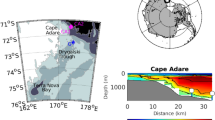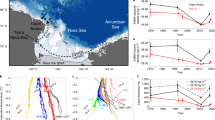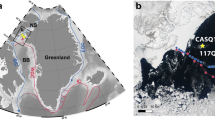Abstract
The formation of Antarctic Bottom Water—the cold, dense water that occupies the abyssal layer of the global ocean—is a key process in global ocean circulation. This water mass is formed as dense shelf water sinks to depth. Three regions around Antarctica where this process takes place have been previously documented. The presence of another source has been identified in hydrographic and tracer data, although the site of formation is not well constrained. Here we document the formation of dense shelf water in the Cape Darnley polynya (65°–69° E) and its subsequent transformation into bottom water using data from moorings and instrumented elephant seals (Mirounga leonina). Unlike the previously identified sources of Antarctic Bottom Water, which require the presence of an ice shelf or a large storage volume, bottom water production at the Cape Darnley polynya is driven primarily by the flux of salt released by sea-ice formation. We estimate that about 0.3–0.7×106 m3 s−1 of dense shelf water produced by the Cape Darnley polynya is transformed into Antarctic Bottom Water. The transformation of this water mass, which we term Cape Darnley Bottom Water, accounts for 6–13% of the circumpolar total.
This is a preview of subscription content, access via your institution
Access options
Subscribe to this journal
Receive 12 print issues and online access
$259.00 per year
only $21.58 per issue
Buy this article
- Purchase on Springer Link
- Instant access to full article PDF
Prices may be subject to local taxes which are calculated during checkout




Similar content being viewed by others
References
Johnson, G. C. Quantifying Antarctic Bottom Water and North Atlantic Deep Water volumes. J. Geophys. Res. 113, C05027 (2008).
Orsi, A. H., Johnson, G. C. & Bullister, J. L. Circulation, mixing, and production of Antarctic Bottom Water. Prog. Oceanogr. 43, 55–109 (1999).
Marshall, J. & Speer, K. Closure of the meridional overturning circulation through Southern Ocean upwelling. Nature Geosci. 5, 171–180 (2012).
Sigman, D. M. & Boyle, E. A. Glacial/interglacial variations in atmospheric carbon dioxide. Nature 407, 859–869 (2000).
Baines, P. G. & Condie, S. in Ocean, Ice, and Atmosphere: Interactions at the Antarctic Continental Margin (eds Jacobs, S. & Weiss, R.) 29–49 (Antarct. Res. Ser., Vol. 75, American Geophysical Union, 1998).
Foster, T. D. & Carmack, E. C. Frontal zone mixing and Antarctic Bottom Water formation in the southern Weddell Sea. Deep Sea Res. Oceanogr. Abstr. 23, 301–317 (1976).
Gordon, A. L., Huber, B. A., Hellmer, H. H. & Ffield, A. Deep and bottom water of the Weddell Sea’s western rim. Science 262, 95–97 (1993).
Fahrbach, E., Harms, S., Rohardt, G., Schröder, M. & Woodgate, R. A. Flow of bottom water in the northwestern Weddell Sea. J. Geophys. Res. 106, 2761–2778 (2001).
Foldvik, A. et al. Ice shelf water overflow and bottom water formation in the southern Weddell Sea. J. Geophys. Res. 109, C02015 (2004).
Jacobs, S. S., Amos, A. F. & Bruchhausen, P. M. Ross Sea oceanography and Antarctic Bottom Water formation. Deep-Sea Res. Oceanogr. Abstr. 17, 935–970 (1970).
Whitworth, T. III & Orsi, A. H. Antarctic bottom water production and export by tides in the Ross Sea. Geophys. Res. Lett. 33, L12609 (2006).
Gordon, A. L. et al. Western Ross Sea continental slope gravity currents. Deep-Sea Res. II 56, 796–817 (2009).
Rintoul, S. R. in Ocean, Ice, and Atmosphere: Interactions at the Antarctic Continental Margin (eds Jacobs, S. & Weiss, R.) 151–171 (Antarct. Res. Ser., Vol. 75, American Geophysical Union, 1998).
Williams, G. D., Bindoff, N. L., Marsland, S. J. & Rintoul, S. R. Formation and export of dense shelf water from the Adélie Depression, East Antarctica. J. Geophys. Res. 113, C04039 (2008).
Williams, G. D. et al. Antarctic Bottom Water from the Adélie and George V Land coast, East Antarctica (140–149° E). J. Geophys. Res. 115, C04027 (2010).
Jacobs, S. S. & Georgi, D. T. in A voyage of discovery (ed. Angel, M.) 43–84 (Pergamon Press, 1977).
Mantisi, F., Beauverger, T., Poisson, A. & Metzl, N. Chlorofluromethanes in the western Indian sector of the Southern Ocean and their relations with geochemical tracers. Mar. Chem. 35, 151–167 (1991).
Meredith, M. P. et al. On the sources of Weddell Gyre Antarctic Bottom Water. J. Geophys. Res. 105, 1093–1104 (2000).
Hoppema, M. et al. Prominent renewal of Weddell Sea Deep Water from a remote source. J. Mar. Res. 59, 257–279 (2001).
Orsi, A. H. & Whitworth, T. III in Hydrographic Atlas of the World Ocean Circulation Experiment (WOCE). Volume 1: Southern Ocean (eds Sparrow, M., Chapman, P. & Gould, J.) (International WOCE Project Office, 2005).
Meijers, A. J. S., Klocker, A., Bindoff, N. L., Williams, G. D. & Marsland, S. J. The circulation and water masses of the Antarctic shelf and continental slope between 30 and 80° E. Deep-Sea Res. II 57, 723–737 (2010).
Middleton, J. H. & Humphries, S. E. Thermohalinestructure and mixing in the region of Prydz Bay, Antarctica. Deep-Sea Res. 36, 1255–1266 (1989).
Nunes Vaz, R. A. & Lennon, G. W. Physical oceanography of the Prydz Bay region of Antarctic waters. Deep-Sea Res. I 43, 603–641 (1996).
Yabuki, T. et al. Possible source of the Antarctic Bottom Water in the Prydz Bay region. J. Oceanogr. 62, 649–655 (2006).
Tamura, T., Ohshima, K. I. & Nihashi, S. Mapping of sea-ice production for Antarctic coastal polynyas. Geophys. Res. Lett. 35, L07606 (2008).
Fedak, M.A. Marine mammals as platforms for oceanographic sampling: A win/win situation for biology and operational oceanography. Mem. Natl Inst. Polar Res. 58, 133–147 (2004).
Charrassin, J-B. et al. Southern Ocean frontal structure and sea-ice formation rates revealed by elephant seals. Proc. Natl Acad. Sci. USA 105, 11634–11639 (2008).
Williams, G. D. et al. Upper ocean stratification and sea ice growth rates during the summer-fall transition, as revealed by Elephant seal foraging in the Adélie Depression, East Antarctica. Ocean Sci. 7, 185–202 (2011).
Massom, R. A., Harris, P. T., Michael, K. J. & Potter, M. J. The distribution and formative processes of latent-heat polynyas in East Antarctica. Ann. Glaciol. 27, 420–426 (1998).
Fraser, A. D., Massom, R. A., Michael, K. J., Galton-Fenzi, B. K. & Lieser, J. L. East Antarctic landfast sea-ice distribution and variability, 2000–2008. J. Clim. 25, 1137–1156 (2012).
Matsumura, Y. & Hasumi, H. Modeling ice shelf water overflow and bottom water formation in the southern Weddell Sea. J. Geophys. Res. 115, C10033 (2010).
Darelius, E., Smedsrud, L. H., Østerhus, S., Foldvik, A. & Gammelsrød, T. Structure and variability of the Filchner overflow plume. Tellus Ser. A 61, 446–464 (2009).
Wang, Q., Danilov, S. & Schröter, J. Bottom water formation in the southern Weddell Sea and the influence of submarine ridges: Idealized numerical simulations. Ocean Model. 28, 50–59 (2008).
Budillon, G., Castagno, P., Aliani, S., Spezie, G. & Padman, L. Thermohaline variability and Antarctic bottom water formation at the Ross Sea shelf break. Deep-Sea Res. I 58, 1002–1018 (2011).
Roquet, F. et al. Delayed-mode calibration of hydrographic data obtained from animal-borne satellite relay data loggers. J. Atmos. Ocean. Technol. 41, 787–801 (2011).
Gordon, A. L., Visbeck, M. & Huber, B. Export of Weddell Sea Deep and Bottom Water. J. Geophys. Res. 106, 9005–9017 (2001).
Orsi, A. H. & Wiederwohl, C. L. A recount of Ross Sea waters. Deep-Sea Res. II 56, 778–795 (2009).
Orsi, A. H., Smethie, W. M. Jr & Bullister, J. L. On the total input of Antarctic waters to the deep ocean: A preliminary estimate from chlorofluorocarbon measurements. J. Geophys. Res. 107, 3122 (2002).
Meredith, M. P., Watson, A. J., van Scoy, K. A. & Haine, T. W. N. Chlorofluorocarbon-derived formation rates of the deep and bottom waters of the Weddell Sea. J. Geophys. Res. 106, 2899–2919 (2001).
Naveira Garabato, A. C., McDonagh, E. L., Stevens, D. P., Heywood, K. J. & Sanders, R. J. On the export of Antarctic Bottom Water from the Weddell Sea. Deep-Sea Res. II 49, 4715–4742 (2002).
Kusahara, K., Hasumi, H. & Williams, G. D. Impact of Mertz Glacier Tongue calving on dense shelf water. Nature Commun. 2, 159 (2011).
Tamura, T., Williams, G. D., Fraser, A. D. & Ohshima, K. I. Potential regime shift in decreased sea ice production after the Mertz Glacier calving. Nature Commun. 3, 826 (2012).
Meredith, M. P., Naveira Garabato, A. C., Gordon, A. L. & Johnson, G. C. Evolution of the deep and bottom waters of the Scotia Sea, Southern Ocean, during 1995–2005. J. Clim. 21, 3327–3343 (2008).
Fahrbach, E. et al. Warming of deep and abyssal water masses along the Greenwich meridian on decadal time scales: The Weddell gyre as a heat buffer. Deep-Sea Res. II 58, 2508–2523 (2011).
Purkey, S. G. & Johnson, G. C. Global contraction of Antarctic Bottom Water between the 1980s and 2000s. J. Clim. 25, 5830–5844 (2012).
Harris, P. T. Ripple cross-laminated sediments on the East Antarctic Shelf: Evidence for episodic bottom water production during the Holocene? Mar. Geol. 170, 317–330 (2000).
Acknowledgements
We are deeply indebted to the officers, crew and scientists on board TR/V Umitaka-maru and R/V Hakuho-maru for their help with field observations. Comments by R. A. Massom and support from K. Shimada and K. Kitagawa were helpful. The AMSR-E and SSM/I data were provided by the National Snow and Ice Data Center (NSIDC), University of Colorado. The ASAR data were provided by European Space Agency. IMOS seal CTD data were provided through the Australian Animal Tracking and Monitoring System, a facility of Integrated Marine Observing System. Isles Kerguelen deployments were supported by the French Spatial Agency (CNES) and the French Polar Institute (IPEV). This work was supported by Grants-in-Aids for Scientific Research (20221001, 20540419, 21740337, 23340135) of the Ministry of Education, Culture, Sports, Science and Technology in Japan, and the Australian Government’s Cooperative Research Centres Programme through the Antarctic Climate & Ecosystem Cooperative Research Centre.
Author information
Authors and Affiliations
Contributions
K.I.O. and Y.F. conducted and analysed mooring observations after planning the experiment with M.W., S.A. and T.T. G.D.W. led the investigation of seal data with calibration by F.R., analysis by L.H-B., and fieldwork by I.F. and M.H. S.N. and T.T. analysed satellite data. Y.K. and D.H. conducted hydrographic observations.
Corresponding authors
Ethics declarations
Competing interests
The authors declare no competing financial interests.
Supplementary information
Supplementary Information
Supplementary Information (PDF 1720 kb)
Rights and permissions
About this article
Cite this article
Ohshima, K., Fukamachi, Y., Williams, G. et al. Antarctic Bottom Water production by intense sea-ice formation in the Cape Darnley polynya. Nature Geosci 6, 235–240 (2013). https://doi.org/10.1038/ngeo1738
Received:
Accepted:
Published:
Issue Date:
DOI: https://doi.org/10.1038/ngeo1738
This article is cited by
-
Circum-Antarctic bottom water formation mediated by tides and topographic waves
Nature Communications (2024)
-
Transiting consolidated ice strongly influenced polynya area during a shrink event in Terra Nova Bay in 2013
Communications Earth & Environment (2023)
-
Decadal oscillation provides skillful multiyear predictions of Antarctic sea ice
Nature Communications (2023)
-
Abyssal ocean overturning slowdown and warming driven by Antarctic meltwater
Nature (2023)
-
Future changes in Antarctic coastal polynyas and bottom water formation simulated by a high-resolution coupled model
Communications Earth & Environment (2023)



